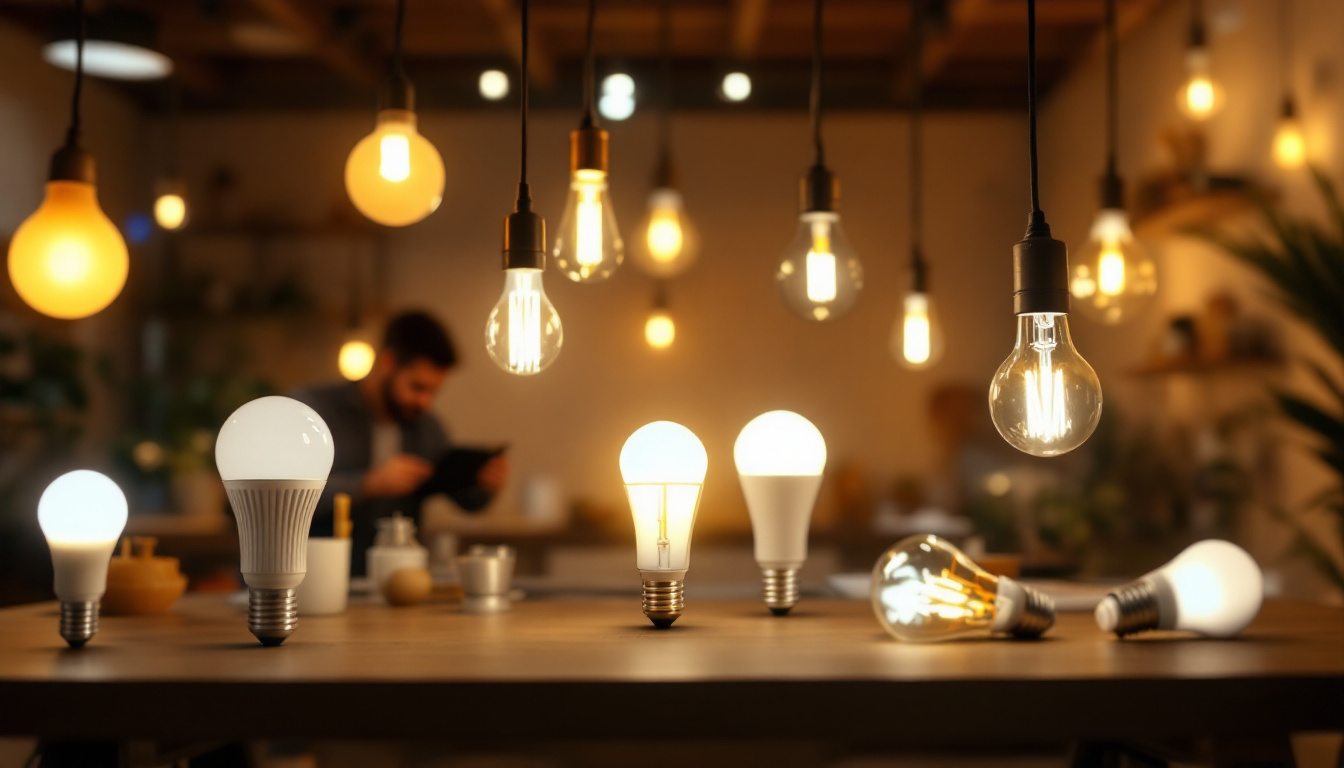
Lighting plays a crucial role in the functionality and aesthetics of a kitchen. For lighting contractors, understanding the best fixtures for this space is essential to delivering quality service and ensuring customer satisfaction. This article explores the best lighting fixtures for kitchens and offers insights on how lighting contractors can avoid common issues.
The kitchen is often referred to as the heart of the home, serving multiple purposes from cooking to entertaining. Therefore, the lighting needs in this area are diverse and multifaceted. It is essential for lighting contractors to assess these needs thoroughly before selecting fixtures. A well-lit kitchen not only enhances functionality but also contributes to the overall ambiance of the home, making it a welcoming space for family and friends alike.
Different tasks in the kitchen require varying levels of illumination. For instance, task lighting is crucial for areas where food preparation occurs, while ambient lighting creates a warm atmosphere for dining and socializing. Understanding these distinctions can help contractors recommend the right fixtures to their clients. Additionally, factors such as the kitchen’s layout, color scheme, and the presence of natural light can influence the choice of lighting, ensuring that the space is both practical and visually appealing.
When considering kitchen lighting, it is important to categorize the types of lighting into three main categories: ambient, task, and accent lighting. Each type serves a unique purpose and can significantly enhance the kitchen’s overall functionality and aesthetics. By strategically combining these types, homeowners can create a layered lighting effect that meets all their cooking and entertaining needs.
Ambient lighting provides general illumination, ensuring that the entire space is well-lit. This can be achieved through ceiling-mounted fixtures, recessed lights, or pendant lights. Task lighting, on the other hand, focuses on specific areas where activities take place, such as under-cabinet lights or pendant lights above an island. These focused beams of light are essential for safety and efficiency, especially when dealing with sharp knives or hot surfaces. Accent lighting adds a decorative touch and highlights specific features, such as artwork or architectural details. Incorporating dimmable options for accent lighting can also allow homeowners to adjust the mood of the kitchen, transitioning from bright and functional during meal prep to soft and inviting during dinner parties.
Moreover, the choice of light bulbs can greatly affect the quality of light in the kitchen. LED bulbs, for example, are energy-efficient and have a long lifespan, making them a popular choice for all types of kitchen lighting. They come in various color temperatures, allowing homeowners to select a warm white for a cozy feel or a cooler white for a more modern, crisp look. Additionally, smart lighting technology is becoming increasingly popular, enabling users to control their kitchen lights remotely or set schedules for different times of the day. This level of customization not only enhances convenience but also allows for energy savings, making it a smart choice for the environmentally conscious homeowner.
Choosing the right fixtures for a kitchen involves considering both functionality and style. Lighting contractors must stay updated on current trends and technologies to offer the best options to their clients. It’s essential to understand the unique layout and design of each kitchen, as this can greatly influence the type of fixtures that will work best. For instance, a kitchen with an open floor plan may benefit from a combination of different lighting sources to create a cohesive look that flows into adjacent spaces.
One of the most popular choices for kitchen lighting is LED fixtures. They are energy-efficient, have a long lifespan, and come in various styles and designs. Additionally, LEDs offer flexibility in terms of color temperature, allowing contractors to create the desired ambiance for their clients. The ability to dim LED lights also adds to their appeal, enabling homeowners to adjust the brightness according to the time of day or occasion, whether it’s a bright and lively breakfast or a cozy dinner setting.
Several fixture styles are particularly popular in modern kitchens. Pendant lights are a favorite for islands and dining areas, providing both task and ambient lighting. They come in a variety of materials, such as glass, metal, and even fabric, allowing for personalization that matches the kitchen’s decor. Chandeliers can add a touch of elegance, especially in larger kitchens with high ceilings. These fixtures can serve as a stunning focal point, drawing the eye upward and enhancing the overall aesthetic of the space. Recessed lighting is ideal for a sleek, minimalist look and can be strategically placed to enhance the overall lighting scheme, ensuring that every corner of the kitchen is well-lit without overwhelming the design.
Another trend gaining traction is the use of smart lighting fixtures. These allow homeowners to control their kitchen lighting through mobile apps or voice commands, providing convenience and versatility. Smart fixtures can be programmed to adjust automatically based on the time of day or even the presence of people in the room, making them not only stylish but also highly functional. Lighting contractors should familiarize themselves with these technologies to meet the evolving demands of their clients. Additionally, integrating smart lighting with other smart home systems can create a seamless experience, allowing for synchronized lighting throughout the home, which is particularly appealing to tech-savvy homeowners.
Despite their expertise, lighting contractors often encounter challenges when working on kitchen projects. Being aware of these issues can help them avoid potential pitfalls and deliver exceptional results.
One common issue is improper fixture placement. Poorly positioned lights can create shadows or fail to provide adequate illumination for specific tasks. Contractors should take the time to assess the layout of the kitchen and the tasks that will be performed in each area before finalizing fixture locations.
Electrical considerations are another critical aspect of kitchen lighting. Contractors must ensure that the existing electrical system can support the new fixtures. This includes checking the wattage and amperage requirements and ensuring that circuits are not overloaded.
Additionally, it is essential to adhere to local building codes and regulations. Failure to comply can lead to safety hazards and costly rework. Contractors should stay informed about these regulations to ensure that their installations are safe and legal.
Effective communication with clients is vital in avoiding misunderstandings and ensuring satisfaction. Lighting contractors should engage their clients in discussions about their preferences, needs, and budget. This collaborative approach can help contractors recommend the best fixtures and designs tailored to the client’s vision.
Providing clients with visual aids, such as mood boards or 3D renderings, can also enhance communication. These tools help clients visualize the proposed lighting solutions, making it easier for them to make informed decisions.
Proper installation is key to the performance and longevity of kitchen lighting fixtures. Lighting contractors should follow best practices to ensure that their installations are both functional and aesthetically pleasing.
One best practice is to use the right mounting hardware and techniques for each type of fixture. For example, pendant lights should be hung at a height that allows for adequate clearance while still providing effective illumination. Recessed lights should be installed at appropriate distances to avoid creating dark spots or overly bright areas.
After installation, testing the lighting setup is crucial. Contractors should evaluate the lighting levels and make adjustments as necessary. This may involve repositioning fixtures or changing bulbs to achieve the desired effect.
Encouraging clients to test the lighting at different times of the day can also help identify any issues. Natural light can significantly affect how artificial lighting appears, so it’s important to consider this variable during the testing phase.
Maintenance is an often-overlooked aspect of kitchen lighting. Educating clients on how to care for their fixtures can prolong their lifespan and maintain optimal performance.
Contractors should recommend regular cleaning schedules to prevent dust and grease buildup, which can diminish the brightness of the fixtures. Additionally, clients should be informed about the importance of replacing burnt-out bulbs promptly to ensure consistent lighting levels.
As trends and technologies evolve, clients may wish to upgrade their kitchen lighting fixtures. Lighting contractors should be prepared to assist with these upgrades, offering advice on the latest products and designs that align with the client’s style and needs.
Encouraging clients to consider energy-efficient options can also be beneficial. Not only do these fixtures reduce energy costs, but they also contribute to a more sustainable environment, which is an increasingly important consideration for many homeowners.
In conclusion, selecting the best lighting fixtures for kitchens involves a comprehensive understanding of the space’s unique needs. Lighting contractors play a vital role in guiding clients through this process, ensuring that they choose fixtures that enhance both functionality and aesthetics.
By being aware of common issues, adhering to best practices, and maintaining open communication with clients, contractors can avoid potential pitfalls and deliver exceptional lighting solutions. Staying informed about the latest trends and technologies will further empower contractors to meet the evolving demands of their clients, ultimately leading to successful projects and satisfied customers.
Ready to elevate your kitchen lighting projects with fixtures that blend form and function? Look no further than LumenWholesale for a vast selection of top-quality, spec-grade lighting products at unbeatable wholesale prices. Our commitment to quality and affordability ensures that you can deliver exceptional lighting solutions to your clients without breaking the bank. Say goodbye to inflated markups and hello to hassle-free bulk buying with free shipping. Don’t compromise on quality or value—choose LumenWholesale for the best in lighting efficiency and design. Wholesale Lighting at the Best Value is just a click away.

Discover the common pitfalls lighting contractors face when working with cylinder lights and learn expert tips to avoid them.

Discover the ultimate guide for lighting contractors on selecting the best LED light bulbs.

Discover how the innovative Led Bi-Pen Wall Wash Up Light can revolutionize lighting projects by saving contractors both time and money.

Discover the key challenges lighting contractors face when implementing LED solutions in warehouses.